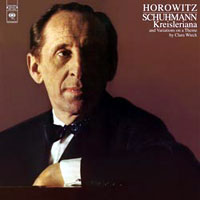Schumann • Kreisleriana Vladimir Horowitz, piano
Behind the scenes, Kreisleriana was Schumann’s exclamation of love for the 16-year-old Clara Wieck, piano prodigy, composer, and daughter of Schumann’s piano teacher, Friedrich Wieck, in whose household Schumann lived since Clara was eleven. Schumann wrote secretly to Clara: "I intend to call it Kreisleriana. You and one of your ideas play the main role in it, and I want to dedicate it to you. . . . A really wild love, as wild as can be, is in some of the movements, your life and mine, and many a flash of your eyes.” They eventually wed, but the gifted Clara never understood the music. It remained Schumann’s favorite, “the one I love most of all,” until his death in an insane asylum 18 years later. Compared to music from Beethoven, Schubert or Schumann’s contemporary Mendelssohn, Kreisleriana was wild. Nothing like it had been heard before. Here was music that spoke of the inner life, music of the moment, intended to invoke emotion in its listener -- a new approach that helped define the nascent Romantic Era. Alternating between madness and unbalanced beauty, Schumann’s eight fantasies took his listener from the dervish to the rapture. The even numbered sketches tended to be slower and semi-idyllic, the odd ones taut with unsettled urgency. None had a steady tempo. Dynamically agitated arpeggios ran amok. Between the frenzies, Schumann turned some exquisitely beautiful phrases, but offered little coherence into which these phrases flowed. The finale brought no happy send-off, no sweet finish; out of energy, the music simply drained away. Kreisleriana felt less like a love song and more like a carnival ride: You got off where you got on, none the wiser, emotions shaken. When Vladimir Horowitz came off a hugely successful concert tour in 1968, featuring both Kreisleriana and Rachmaninoff’s Sonata No. 2 in B-flat minor, he was the world’s highest-paid concert pianist. Columbia Records taped every concert, and they wanted to sell albums from it. A record of Horowitz’s live Rachmaninoff performance won him two of his eventual 25 Grammys. But this was the first time he publicly played Kreisleriana. The critics were not impressed and neither was the hyper-finicky maestro. He judged the tapes of his Schumann performances unfit for release. Horowitz fed off his audience and hated the sterility of playing without one, but his manager eventually coaxed him into Columbia’s New York studio in 1969, where he recorded the Kreisleriana we have here, coupling it with Schumann’s brief Variations on a Theme by Clara Wieck, four variations on a sweet melody that actually sounded like a love song. Horowitz was born to play Schumann. His nervous temperament and edgy virtuosity lent themselves to Kreisleriana’s fiery passion and tender moments. Always a master of tempo, Horowitz felt at home with the music’s constantly shifting time signatures, his strong hands helped him play the big crescendos without banging, his pedal technique was never zealous, and he easily sustained notes without it. While he occasionally made mistakes (he always did), his audiences never cared. His performance did not have the every-note-is-a-unique-event quality of a pianist such as Michelangeli, but the music did not demand it. Horowitz’s 1969 recording managed to bring a semblance of meaning and cohesion to Schumann’s manic-depressive self-portrait. The clarity of this all-Schumann studio album was easily
superior to Horowitz’s live concert recordings. The microphone placements were
neither too far nor too close, resulting in a superbly reproduced perspective on a solo
piano. As with all their Columbia Masterwork re-releases, Speakers Corner made this record
from the original analog master tapes. Masterdisk in New York cut the lacquer, Quality
Record Pressings made the metal stampers, and Pallas in Germany did the final
manufacturing. No digital processes interfered at any point in the chain. The end result
is quality work; but for the absence of audience noise, it sounds live, and the LP was
flat with perfect surfaces. |

 n April of
1838, Robert Schumann poured out Kreisleriana for solo piano in barely a week. He
formally dedicated the piece to his friend Chopin. Ostensibly, it offered eight vignettes
depicting the life of Kapellmeister Johannes Kreisler, a half-crazed composer-conductor
created by the popular poet ETA Hoffman in a fictional series of zany short stories.
Schumann never revealed the musical connection between his piece and Hoffman’s tales.
n April of
1838, Robert Schumann poured out Kreisleriana for solo piano in barely a week. He
formally dedicated the piece to his friend Chopin. Ostensibly, it offered eight vignettes
depicting the life of Kapellmeister Johannes Kreisler, a half-crazed composer-conductor
created by the popular poet ETA Hoffman in a fictional series of zany short stories.
Schumann never revealed the musical connection between his piece and Hoffman’s tales.